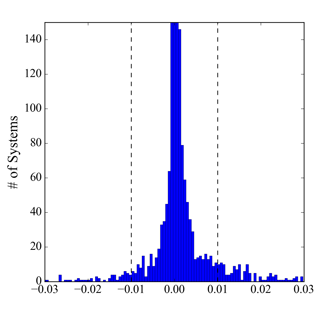I have a sample of ~3,000 star systems, and I've found the distribution of a particular parameter. I'd like to find the standard deviation of this distribution, and so I've used the standard deviation equation I'm familiar with:
$\sigma = \sqrt{\frac{1}{N - 1}\sum_{n = 0}^{N}{(x_n^2 - \bar{x}^2)}}\tag{1}$
However, the standard deviation this gives is much too large. The two graphs below show the distribution and a zoomed-in view of the distribution:
Equation 1 gives $\sigma = 0.0083$, but the graphs above show that $\sigma \approx 0.001$. The distribution is clearly non-Gaussian. I'm not sure if Equation 1 holds for non-Gaussian distributions, but I'm unsure about how I would go about calculating a standard deviation. I'm also not sure if things like the central limit theorem apply here, because that seems limited to random selections from a population, while this is simply the entire population. What's the correct methodology to find $\sigma$ for this case?


